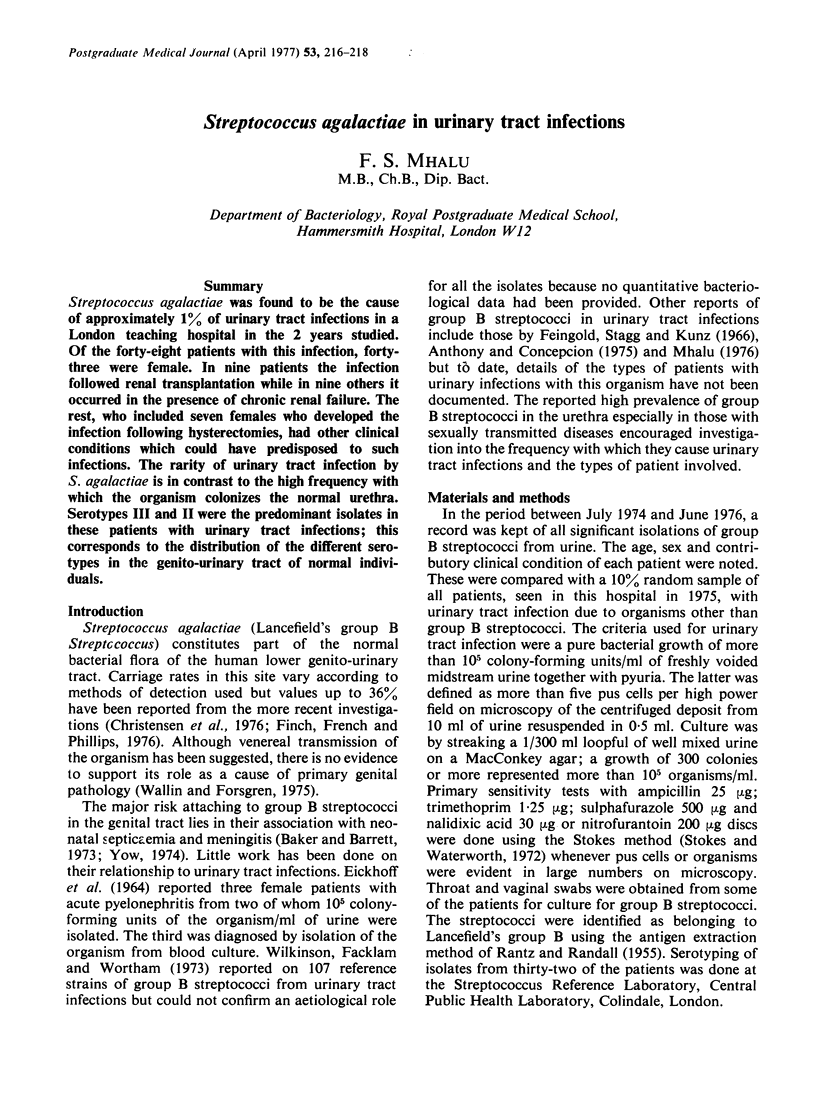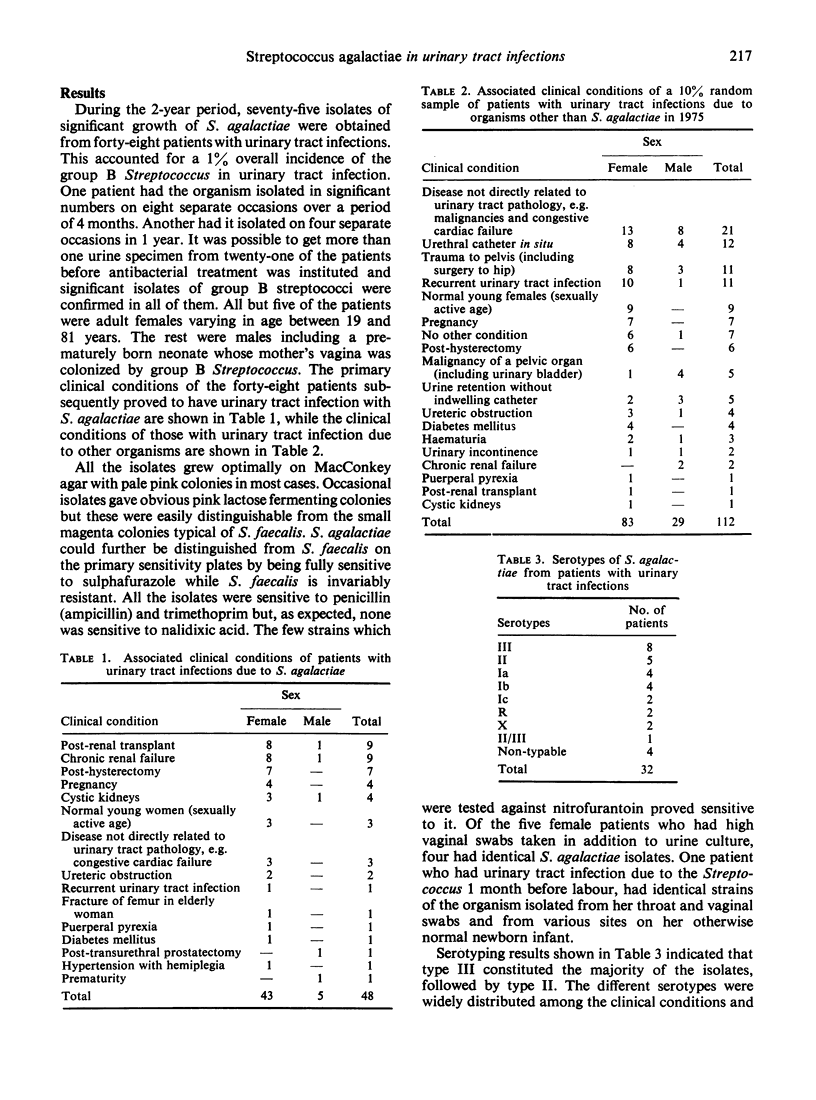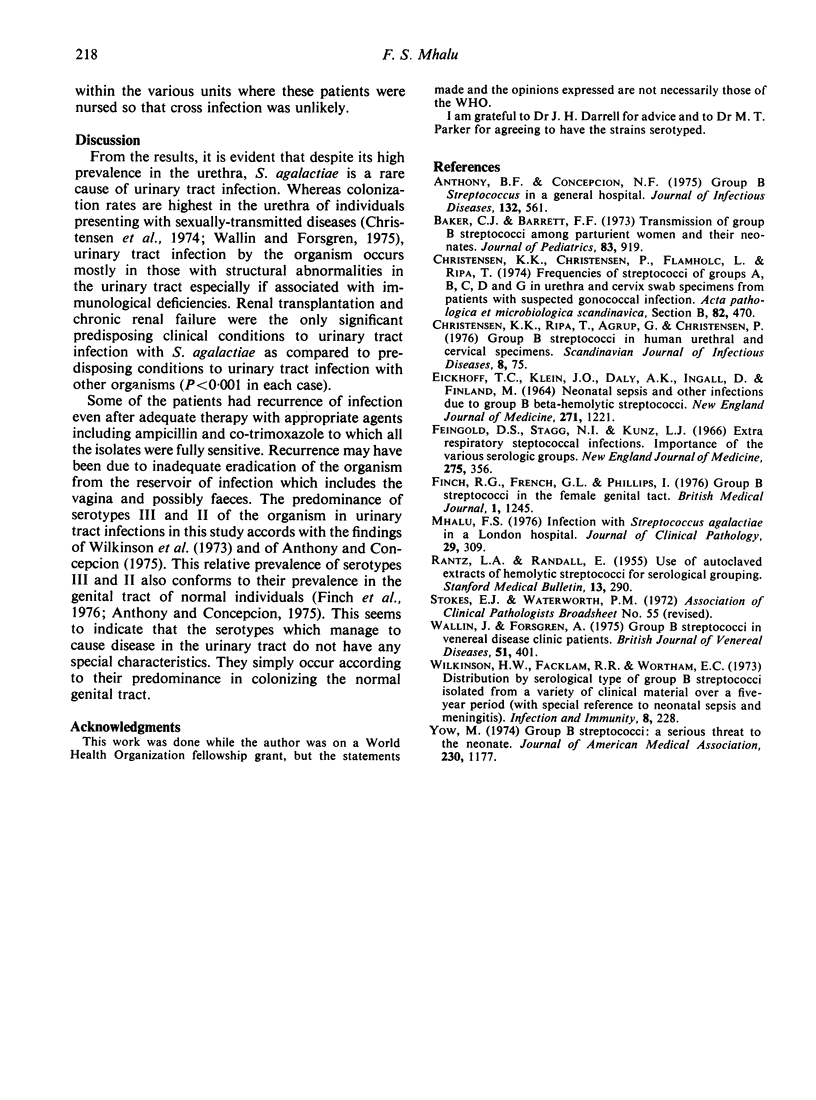Abstract
Streptococcus agalactiae was found to be the cause of approximately 1% of urinary tract infections in a London teaching hospital in the 2 years studied. Of the forty-eight patients with this infection, forty-three were female. In nine patients the infection followed renal transplantation while in nine others it occurred in the presence of chronic renal failure. The rest, who included seven females who developed the infection following hysterectomies, had other clinical conditions which could have predisposed to such infections. The rarity of urinary tract infection by S. agalactiae is in contrast to the high frequency with which the organism colonizes the normal urethra. Serotypes III and II were the predominant isolates in these patients with urinary tract infections; this corresponds to the distribution of the different serotypes in the genito-urinary tract of normal individuals.
Full text
PDF


Selected References
These references are in PubMed. This may not be the complete list of references from this article.
- Anthony B. F., Concepcion N. F. Group B streptococcus in a general hospital. J Infect Dis. 1975 Nov;132(5):561–567. doi: 10.1093/infdis/132.5.561. [DOI] [PubMed] [Google Scholar]
- Baker C. J., Barrett F. F. Transmission of group B streptococci among parturient women and their neonates. J Pediatr. 1973 Dec;83(6):919–925. doi: 10.1016/s0022-3476(73)80524-4. [DOI] [PubMed] [Google Scholar]
- Christensen K. K., Christensen P., Flamholc L., Ripa T. Frequencies of streptococci of groups A, B, C, D, and G in urethra and cervix swab specimens from patients with suspected gonococcal infection. Acta Pathol Microbiol Scand B Microbiol Immunol. 1974 Aug;82(4):470–474. doi: 10.1111/j.1699-0463.1974.tb02355.x. [DOI] [PubMed] [Google Scholar]
- Christensen K. V., Ripa T., Agrup G., Christensen P. Group B streptococci in human urethral and cervical specimens. Scand J Infect Dis. 1976;8(2):75–78. doi: 10.3109/inf.1976.8.issue-2.03. [DOI] [PubMed] [Google Scholar]
- EICKHOFF T. C., KLEIN J. O., DALY A. K., INGALL D., FINLAND M. NEONATAL SEPSIS AND OTHER INFECTIONS DUE TO GROUP B BETA-HEMOLYTIC STREPTOCOCCI. N Engl J Med. 1964 Dec 10;271:1221–1228. doi: 10.1056/NEJM196412102712401. [DOI] [PubMed] [Google Scholar]
- Feingold D. S., Stagg N. L., Kunz L. J. Extrarespiratory streptococcal infections. Importance of the various serologic groups. N Engl J Med. 1966 Aug 18;275(7):356–361. doi: 10.1056/NEJM196608182750704. [DOI] [PubMed] [Google Scholar]
- Finch R. G., French G. L., Phillips I. Group B streptococci in the female genital tract. Br Med J. 1976 May 22;1(6020):1245–1247. doi: 10.1136/bmj.1.6020.1245. [DOI] [PMC free article] [PubMed] [Google Scholar]
- Mhalu F. S. Infection with Streptococcus agalactiae in a London hospital. J Clin Pathol. 1976 Apr;29(4):309–312. doi: 10.1136/jcp.29.4.309. [DOI] [PMC free article] [PubMed] [Google Scholar]
- RANTZ L. A., RANDALL E. Use of autoclaved extracts of hemolytic streptococci for serological grouping. Stanford Med Bull. 1955 May;13(2):290–291. [PubMed] [Google Scholar]
- Wallin J., Forsgren A. Group B streptococci in venereal disease clinic patients. Br J Vener Dis. 1975 Dec;51(6):401–404. doi: 10.1136/sti.51.6.401. [DOI] [PMC free article] [PubMed] [Google Scholar]
- Wilkinson H. W., Facklam R. R., Wortham E. C. Distribution by serological type of group B streptococci isolated from a variety of clinical material over a five-year period (with special reference to neonatal sepsis and meningitis). Infect Immun. 1973 Aug;8(2):228–235. doi: 10.1128/iai.8.2.228-235.1973. [DOI] [PMC free article] [PubMed] [Google Scholar]
- Yow M. Editorial: Group B streptococci: a serious threat to the neonate. JAMA. 1974 Nov 25;230(8):1177–1178. [PubMed] [Google Scholar]


